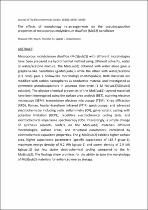 ResearchSpace
ResearchSpace
The effects of morphology re-arrangements on the pseudocapacitive properties of mesoporous molybdenum disulfide (MoS2) nanoflakes
JavaScript is disabled for your browser. Some features of this site may not work without it.
- ResearchSpace
- →
- Research Publications/Outputs
- →
- Journal Articles
- →
- View Item
| dc.contributor.author |
Khawula, TNY

|
|
| dc.contributor.author |
Raju, Kumar

|
|
| dc.contributor.author |
Franklyn, PJ

|
|
| dc.contributor.author |
Sigalas, I

|
|
| dc.contributor.author |
Ozoemena, Kenneth I

|
|
| dc.date.accessioned | 2017-07-28T09:09:12Z | |
| dc.date.available | 2017-07-28T09:09:12Z | |
| dc.date.issued | 2016-07 | |
| dc.identifier.citation | Khawula, T.N.Y., Raju, K., Franklyn, P.J. et al. 2016. The effects of morphology re-arrangements on the pseudocapacitive properties of mesoporous molybdenum disulfide (MoS2) nanoflakes. Journal of The Electrochemical Society, vol. 163(8): A1927-A1935. doi: 10.1149/2.0601609jes | en_US |
| dc.identifier.issn | 0013-4651 | |
| dc.identifier.uri | doi: 10.1149/2.0601609jes | |
| dc.identifier.uri | http://jes.ecsdl.org/content/163/9/A1927.abstract | |
| dc.identifier.uri | http://hdl.handle.net/10204/9372 | |
| dc.description | Copyright: 2016 The Authors. | en_US |
| dc.description.abstract | Mesoporous molybdenum disulfide (MoS(sub2)) with different morphologies have been prepared via hydrothermal method using different solvents, water or water/acetone mixture. The MoS(sub2) obtained with water alone gave a graphene-like nanoflakes (g-MoS(sub2)) while the other with water/acetone (1:1 ratio) gave a hollow-like morphology (h-MoS(sub2)). Both materials are modified with carbon nanospheres as conductive material and investigated as symmetric pseudocapacitors in aqueous electrolyte (1 M Na(sub2)SO(sub4) solution). The physico-chemical properties of the MoS(sub2) layered materials have been interrogated using the surface area analysis (BET), scanning electron microscopy (SEM), transmission electron microscopy (TEM), X-ray diffraction (XRD), Raman, fourier-transform infrared (FTIR) spectroscopy, and advanced electrochemistry including cyclic voltammetry (CV), galvanostatic cycling with potential limitation (GCPL), repetitive electrochemical cycling tests, and electrochemical impedance spectroscopy (EIS). Interestingly, a simple change of synthesis solvents confers on the MoS(sub2) materials different morphologies, surface areas, and structural parameters, correlated by electrochemical capacitive properties. The g-MoS(sub2) exhibits higher surface area, higher capacitance parameters (specific capacitance of 183 F g(sup-1), maximum energy density of 9.2 Wh kg(sup-1) and power density of 2.9 kW kg(sup-1)) but less stable electrochemical cycling compared to the h-MoS(sub2). The findings show promises for the ability to tune the morphology of MoS(sub2) materials for enhanced energy storage. | en_US |
| dc.language.iso | en | en_US |
| dc.publisher | Electrochemical Society Incorporated | en_US |
| dc.relation.ispartofseries | Worklist;17827 | |
| dc.subject | Mesoporous molybdenum disulfide | en_US |
| dc.subject | Electrochemical cycling tests | en_US |
| dc.subject | Energy storage | en_US |
| dc.title | The effects of morphology re-arrangements on the pseudocapacitive properties of mesoporous molybdenum disulfide (MoS2) nanoflakes | en_US |
| dc.type | Article | en_US |
| dc.identifier.apacitation | Khawula, T., Raju, K., Franklyn, P., Sigalas, I., & Ozoemena, K. I. (2016). The effects of morphology re-arrangements on the pseudocapacitive properties of mesoporous molybdenum disulfide (MoS2) nanoflakes. http://hdl.handle.net/10204/9372 | en_ZA |
| dc.identifier.chicagocitation | Khawula, TNY, Kumar Raju, PJ Franklyn, I Sigalas, and Kenneth I Ozoemena "The effects of morphology re-arrangements on the pseudocapacitive properties of mesoporous molybdenum disulfide (MoS2) nanoflakes." (2016) http://hdl.handle.net/10204/9372 | en_ZA |
| dc.identifier.vancouvercitation | Khawula T, Raju K, Franklyn P, Sigalas I, Ozoemena KI. The effects of morphology re-arrangements on the pseudocapacitive properties of mesoporous molybdenum disulfide (MoS2) nanoflakes. 2016; http://hdl.handle.net/10204/9372. | en_ZA |
| dc.identifier.ris | TY - Article AU - Khawula, TNY AU - Raju, Kumar AU - Franklyn, PJ AU - Sigalas, I AU - Ozoemena, Kenneth I AB - Mesoporous molybdenum disulfide (MoS(sub2)) with different morphologies have been prepared via hydrothermal method using different solvents, water or water/acetone mixture. The MoS(sub2) obtained with water alone gave a graphene-like nanoflakes (g-MoS(sub2)) while the other with water/acetone (1:1 ratio) gave a hollow-like morphology (h-MoS(sub2)). Both materials are modified with carbon nanospheres as conductive material and investigated as symmetric pseudocapacitors in aqueous electrolyte (1 M Na(sub2)SO(sub4) solution). The physico-chemical properties of the MoS(sub2) layered materials have been interrogated using the surface area analysis (BET), scanning electron microscopy (SEM), transmission electron microscopy (TEM), X-ray diffraction (XRD), Raman, fourier-transform infrared (FTIR) spectroscopy, and advanced electrochemistry including cyclic voltammetry (CV), galvanostatic cycling with potential limitation (GCPL), repetitive electrochemical cycling tests, and electrochemical impedance spectroscopy (EIS). Interestingly, a simple change of synthesis solvents confers on the MoS(sub2) materials different morphologies, surface areas, and structural parameters, correlated by electrochemical capacitive properties. The g-MoS(sub2) exhibits higher surface area, higher capacitance parameters (specific capacitance of 183 F g(sup-1), maximum energy density of 9.2 Wh kg(sup-1) and power density of 2.9 kW kg(sup-1)) but less stable electrochemical cycling compared to the h-MoS(sub2). The findings show promises for the ability to tune the morphology of MoS(sub2) materials for enhanced energy storage. DA - 2016-07 DB - ResearchSpace DP - CSIR KW - Mesoporous molybdenum disulfide KW - Electrochemical cycling tests KW - Energy storage LK - https://researchspace.csir.co.za PY - 2016 SM - 0013-4651 T1 - The effects of morphology re-arrangements on the pseudocapacitive properties of mesoporous molybdenum disulfide (MoS2) nanoflakes TI - The effects of morphology re-arrangements on the pseudocapacitive properties of mesoporous molybdenum disulfide (MoS2) nanoflakes UR - http://hdl.handle.net/10204/9372 ER - | en_ZA |





